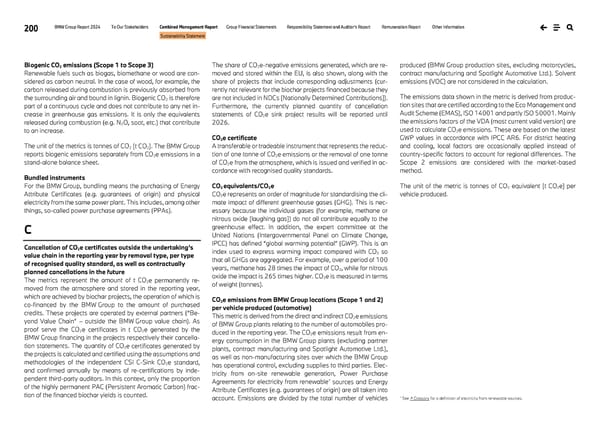200 BMW Group Report 2024 To Our Stakeholders Combined Management Report Group Financial Statements Responsibility Statement and Auditor’s Report Remuneration Report Other Information Sustainability Statement Biogenic CO2 emissions (Scope 1 to Scope 3) Renewable fuels such as biogas, biomethane or wood are con- sidered as carbon neutral. In the case of wood, for example, the carbon released during combustion is previously absorbed from the surrounding air and bound in lignin. Biogenic CO2 is therefore part of a continuous cycle and does not contribute to any net in- crease in greenhouse gas emissions. It is only the equivalents released during combustion (e.g. N2O, soot, etc.) that contribute to an increase. The unit of the metrics is tonnes of CO2 [t CO2]. The BMW Group reports biogenic emissions separately from CO2e emissions in a stand-alone balance sheet. Bundled instruments For the BMW Group, bundling means the purchasing of Energy Attribute Certificates (e.g. guarantees of origin) and physical electricity from the same power plant. This includes, among other things, so-called power purchase agreements (PPAs). C Cancellation of CO2e certificates outside the undertaking’s value chain in the reporting year by removal type, per type of recognised quality standard, as well as contractually planned cancellations in the future The metrics represent the amount of t CO2e permanently re- moved from the atmosphere and stored in the reporting year, which are achieved by biochar projects, the operation of which is co-financed by the BMW Group to the amount of purchased credits. These projects are operated by external partners (“Be- yond Value Chain” – outside the BMW Group value chain). As proof serve the CO2e certificates in t CO2e generated by the BMW Group financing in the projects respectively their cancella- tion statements. The quantity of CO2e certificates generated by the projects is calculated and certified using the assumptions and methodologies of the independent CSI C-Sink CO2e standard, and confirmed annually by means of re-certifications by inde- pendent third-party auditors. In this context, only the proportion of the highly permanent PAC (Persistent Aromatic Carbon) frac- tion of the financed biochar yields is counted. The share of CO2e-negative emissions generated, which are re- moved and stored within the EU, is also shown, along with the share of projects that include corresponding adjustments (cur- rently not relevant for the biochar projects financed because they are not included in NDCs [Nationally Determined Contributions]). Furthermore, the currently planned quantity of cancellation statements of CO2e sink project results will be reported until 2026. CO2e certificate A transferable or tradeable instrument that represents the reduc- tion of one tonne of CO2e emissions or the removal of one tonne of CO2e from the atmosphere, which is issued and verified in ac- cordance with recognised quality standards. CO2 equivalents/CO2e CO2e represents an order of magnitude for standardising the cli- mate impact of different greenhouse gases (GHG). This is nec- essary because the individual gases (for example, methane or nitrous oxide [laughing gas]) do not all contribute equally to the greenhouse effect. In addition, the expert committee at the United Nations (Intergovernmental Panel on Climate Change, IPCC) has defined “global warming potential” (GWP). This is an index used to express warming impact compared with CO2 so that all GHGs are aggregated. For example, over a period of 100 years, methane has 28 times the impact of CO2, while for nitrous oxide the impact is 265 times higher. CO2e is measured in terms of weight (tonnes). CO2e emissions from BMW Group locations (Scope 1 and 2) per vehicle produced (automotive) This metric is derived from the direct and indirect CO2e emissions of BMW Group plants relating to the number of automobiles pro- duced in the reporting year. The CO2e emissions result from en- ergy consumption in the BMW Group plants (excluding partner plants, contract manufacturing and Spotlight Automotive Ltd.), as well as non-manufacturing sites over which the BMW Group has operational control, excluding supplies to third parties. Elec- tricity from on-site renewable generation, Power Purchase Agreements for electricity from renewable* sources and Energy Attribute Certificates (e.g. guarantees of origin) are all taken into account. Emissions are divided by the total number of vehicles produced (BMW Group production sites, excluding motorcycles, contract manufacturing and Spotlight Automotive Ltd.). Solvent emissions (VOC) are not considered in the calculation. The emissions data shown in the metric is derived from produc- tion sites that are certified according to the Eco Management and Audit Scheme (EMAS), ISO 14001 and partly ISO 50001. Mainly the emissions factors of the VDA (most current valid version) are used to calculate CO2e emissions. These are based on the latest GWP values in accordance with IPCC AR6. For district heating and cooling, local factors are occasionally applied instead of country-specific factors to account for regional differences. The Scope 2 emissions are considered with the market-based method. The unit of the metric is tonnes of CO2 equivalent [t CO2e] per vehicle produced. * See ↗ Glossary for a definition of electricity from renewable sources.
 BMW Group Report 2024 Page 199 Page 201
BMW Group Report 2024 Page 199 Page 201